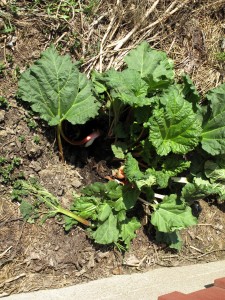20MinuteJim made a good deal with a friend: a clump of rhubarb plants from our kitchen garden in exchange for a fantastic rhubarb pie recipe. We did our part. I’m anxiously waiting to try the recipe!
A quick aside here: when I speak of “transplanting rhubarb”, I mean something closer to “dividing and sharing” rhubarb. I do not mean “moving rhubarb” because eliminating rhubarb from a spot where it has become established is recognized by most home gardeners as a highly challenging undertaking. Therefore, when you plant rhubarb, do so with a sense of commitment and serenity about having given your rhubarb a permanent home in your garden.
How does one transplant rhubarb? Here’s the easy steps to follow:
1. Choose a well-established plant to divide.
2. Use a spade to dig deeply around the plant to be sure to get a good portion of the plant’s roots. If you aren’t trying to move the whole plant, you can chop off a section of the plant. Just be sure to dig deep enough to get the root part as well.
3. If you wish, you can use a spade or garden knife to divide the plant you’ve dug up into multiple plantings. Each division should have 1 or 2 buds and a share of the root system.
4. For easy transport, put the plants with roots down into a plastic bag. This will also keep the roots from drying out.
5. Plant the rhubarb transplant as soon as possible, preferably within 24 hours. Do not allow the roots to dry out.
6. Rhubarb is happiest in the full sun. Avoid shady spots under trees or near shrubs.
7. Plant each division in the planting hole with the buds 1 to 2 inches below the surface of the soil. The plants should be placed about 3 feet apart.
8. Water thoroughly. Keep well watered during the first season.
It’s recommended that you don’t harvest rhubarb for the first two years to allow the plant to become well-established. Rhubarb can produce well for an 8 – 15 year period.
Rhubarb is a hardy, perennial crop. It doesn’t grow everywhere! Rhubarb requires temperatures below 40 F to break dormancy and to stimulate spring growth. Michigan, along with the rest of the northern U.S. and Canada, is certainly the right place for that! Rhubarb prefers summer temperatures averaging less than 75 F for its growth stage. It turns out the kind of spring weather we’ve been having (cool with lots of rain and a fair amount of sun) is exactly what rhubarb likes.



